#athabascan culture
Explore tagged Tumblr posts
Text
this is a great time of year to buy from native stores or donate to native organizations. you can figure out who's land you're on here, and below i've listed some (of many) businesses you can support ♡




B.Yellowtail --- jewlery, clothing, and home goods designed by Bethany Yellowtail, citizen of the Northern Cheyenne Nation and from the Apsáalooke (Crow) Nation
Cheekbone Beauty --- sustainable, low-waste beauty products from Jenn Harper, an Anishinaabe artist based in Canada
Trickster --- atheletic products from Tlingit and Deg Hit’an Athabascan siblings (Alaska)
NativeHumboldt on Etsy --- the artist, Shayna McCullough, and their fiancé make designs inspired by traditional designs from their culture; she is from the Yurok tribe and descended from the Hupa, Karuk, Redwood Creek, Pit River, Yuki, Wintun, Pomo (tribes in California), and Chetco tribe (in Oregon)
OklahomaThirtyNine on Etsy --- they mostly sell beaded work, particularly earrings, as well as some necklaces
xBeadsByMandyx on Etsy --- handmade beaded earrings, from a Cherokee veteran
food products, from wine to sauces to teas to mixes to fish to jerky and nuts, sorted by store with details beside each store

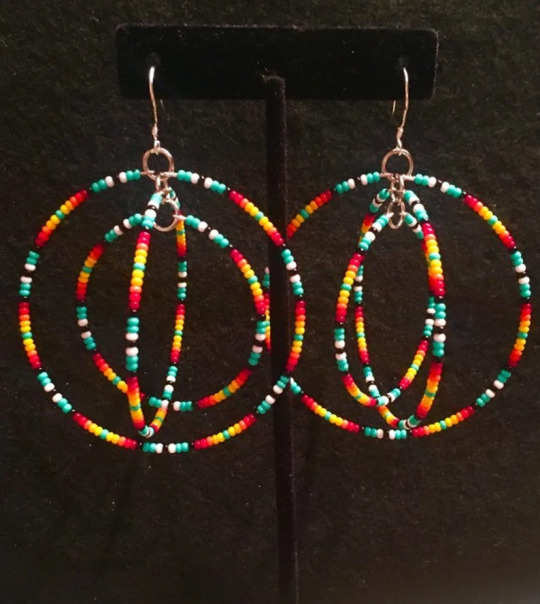
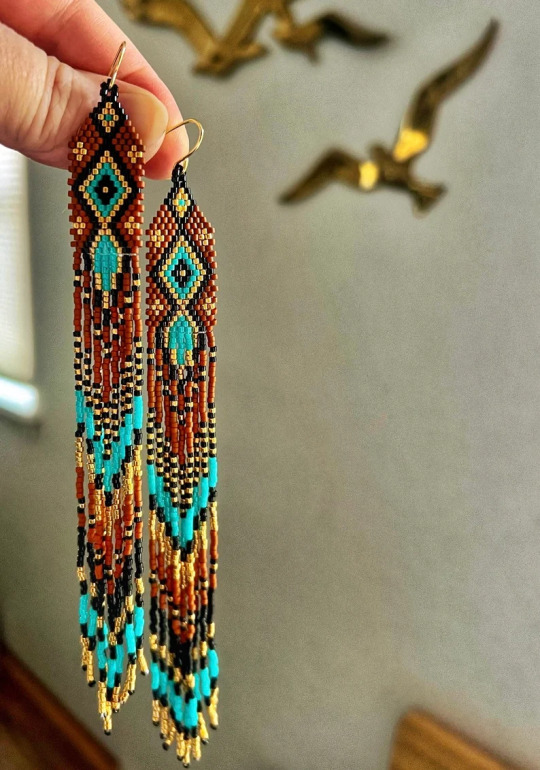
#indigenous people's day#art#native art#culture#food#indigenous#native american#native businesses#buy native#small business
6K notes
·
View notes
Text
The Alaska Senate unanimously joined the state House Friday in urging President Donald Trump to reverse his decision to rename North America’s tallest peak as Mount McKinley.
Trump issued the order renaming Denali after President William McKinley on his first day back in office, saying he was a “natural businessman” who “made our country very rich through tariffs.”
The decision created an uproar around the state. A public opinion poll found Alaskans opposed the change by a two-to-one margin. Sen. Scott Kawasaki, D-Fairbanks, said Denali is a name with deep roots in Alaska’s history and culture.
"Alaskans and travelers from around the world have known it to be Denali. The Athabascan people have lived in the Interior for thousands of years, and for thousands of years have embraced Denali as its proper name," he said.
The state of Alaska has called the peak Denali for decades, a word that comes from a Koyukon Athabascan word with a meaning akin to "high" or "tall." The state renamed the peak as Denali on state maps and databases in 1975 and formally requested that the federal government do the same. The congressional delegation from McKinley’s home state of Ohio successfully blocked the change until 2015, when the Obama administration formally renamed it Denali.
Some state House minority Republicans opposed the resolution last month and looked to amend it to include a message thanking the Trump administration for another order seeking to expand resource development in Alaska. But there was no such opposition in the Senate.
"I think in the spirit of it, I want to honor what the people of Alaska want in this case," said Senate Minority Leader Mike Shower, R-Wasilla. "To those in D.C. that seem to be looking to change certain things — that's fine, but let's pick something that would be a reasonable thing that would not upset the people of Alaska."
The resolution passed by a combined vote of 50 to 8. It’ll be sent to Trump, Alaska’s congressional delegation, the Interior Secretary and the U.S. Board on Geographic Names.
45 notes
·
View notes
Note
Have you seen the formline art in splatoon? It's present in a variety of salmon run decals and on some of the locker graffiti. Idk if the Devs just googled "salmon art" and got indigenous art and decided to copy it or what. Not sure how I feel about it personally.
Long post incoming, gonna put a break here. Also sorry for the late response, I wanted to take a couple days to formalize my thoughts together before responding fully.
I have, I remember noticing in 2018-2019 (when i first started playing splatoon 2) how much one of the decals/graffiti located on the ruins of ark polaris back in 2 sort of resembled a formline bear and salmon. (near the logo in this screenshot, I couldn't find a clear picture online)
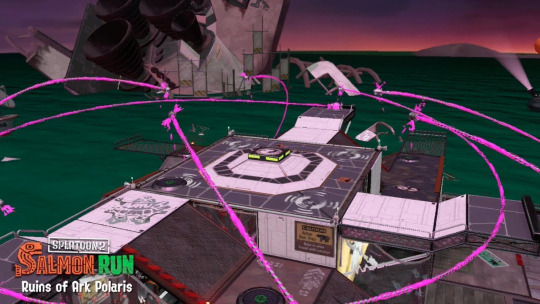
Back in 2019, it was pretty easy to think of it as coincidence or a stretch for a comparison. But with splatoon 3's salmon run decals, the resemblance is far easier to see, specifically with the TS-ORBRS graffiti and the TS-SCHL graffiti.






(also this was the best image size I could find for the graffiti images, sorry)
A couple of the banners have the designs on them as well:


The website Sealaska Heritage has info such as textbooks and an online doc about formline art (specifically geared towards Haida, Tlingit, and Tsimshian nations' style) with lots of info about formline art, and the Seattle Art Museum website has an info sheet (with credits listed as being from the Sealaska Heritage site as well) breaking down some of the basic shapes of formline art.

with this chart, you can definitely begin to notice the similarities between the Salmon Run graffiti and formline art. the ovoids, crescents, and u-shapes appear noticeably in some of the graffiti such as ORBRS and SCHL.
For perspective, here are some formline pieces featuring salmon or fish from various Indigenous artists from various nations.
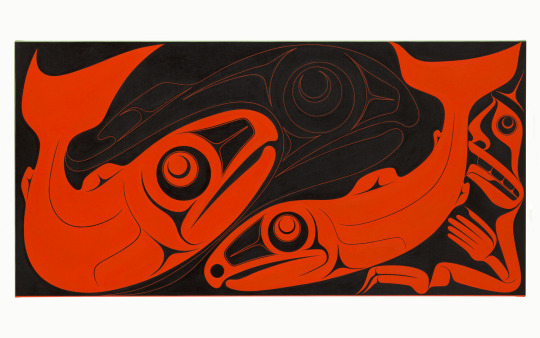
"sk’ug sdang" (Two Dog Salmon) by Robert Davidson (Haida)
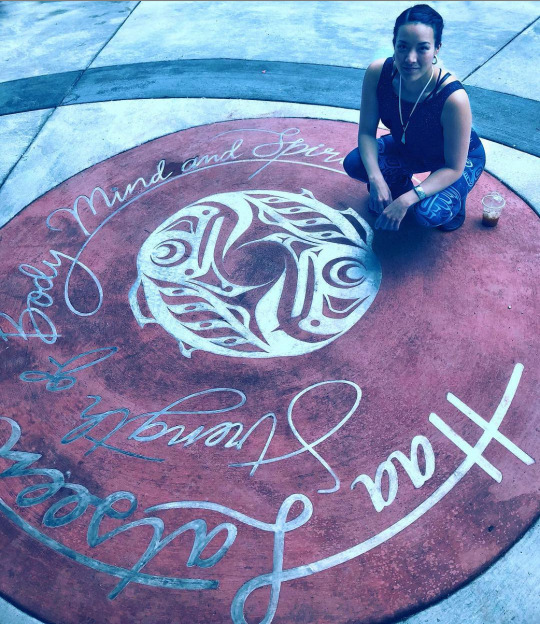
"metal medallion", by Crystal Kaakeeyáa Rose Demientieff Worl (Tlingit Athabascan)

"Salmon People" by Alano Edzerza (Tahltan)
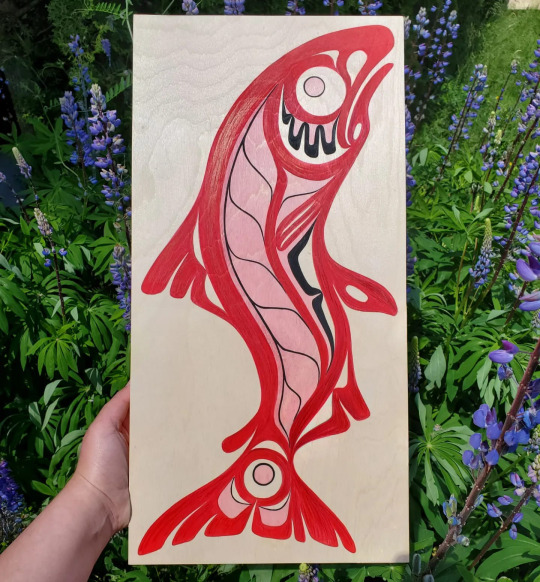
"Jumping Chum" by Stephanie Anderson (Wet'suwet'en)

"Salmon" by Art Thompson (Nuu-chah-nulth)
And that's literally just the surface of dozens of Indigenous artists from the PNW.
With these pieces, you can begin to see the resemblance that the graffiti designs have. A lot of the heads follow the pattern of utilizing ovoids for both the head and eyes, and u-shapes for the bodies and crescents to fill in specific areas are also common. For example, TS-SCHL has a small school of fish where the bodies are entire ovoids.
However, there are a couple flaws in the graffiti designs too. With a few of the designs, you can see they utilize the u-shape (see the formline shape breakdown from Sealaska again) in designs like TS-WHP and TS-SMFR. I can't speak for every Indigenous formline artist ever, but from how I've been taught to design formline art from my family, the u-shape should connect to the rest of the form instead of free-floating. I drew a quick example here:

you can see similar mistakes with a different kind of u-shape with TS-RLPL and TS-C0HK.
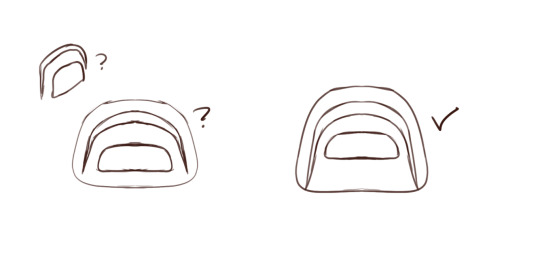
Another very specific mistake that takes a bit of squinting to make out is that ovoids are sort of top-heavy, for lack of a term I can't think of right now. The line or the area should be thicker on the top then the bottom. This mistake is frequent in the graffiti designs utilizing ovoid or ovoid adjacent face or body shapes, like TS-ORBRS, TS-C0HK or TS-SCHL.
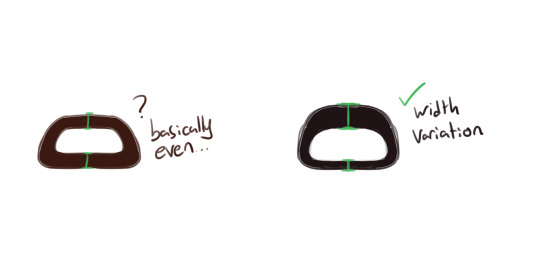
Full disclaimer, I am not an expert at formline art. I've been practicing it under the tutelage of my aunt and father for about 3 or so years now, and there are definitely cultural variations that come into play as well. My culture's formline art style can look completely different from someone who is Haida or otherwise. This critique of the graffiti designs is based off my knowledge and skill at formline art, as well as critique and feedback that I've gotten from family. Formline art isn't just something you look at and replicate, there is a specific process of utilizing the shapes and negative space that you need to account for too. Some shapes have their own rules for how they're used as well.
Despite the beginner mistakes, the clear resemblances are pretty definitive proof that a good section of the sticker/graffiti designs for the salmonids are meant to be, or at the very least based off of or inspired by, formline art.
Splatoon's lore has a lot of elements of taking inspiration from real life culture (which is sort of one of the main elements of the story, the squids and octos are basing their society off long dead humans). Hell, Shiver and Frye are two prime examples of Splatoon working in real world culture into their setting and characters.
With that in mind, using an art style that's exclusive to an ethnicity of people as inspiration or baseline reference for the game mode that's all about taking natural resources from a species that in-game dialogue tends to treat as dangerous and lesser-minded is... not a good choice. Especially an ethnicity that has historically been ravaged and attacked by settlers for natural resources.
Now, technically if you do digging into lore for salmon run, you can find out that the salmonid are not as simple-minded as the dialogue in-game (I am staring directly at the deep cut big run announcement dialogue we've gotten so far -_-) makes them out to be. The salmonids do trades and commerce with the octarians for equipment and gear. That's why they have such technically high tech gear, like the scrappers with their shields that actually resemble octarian shields and the flyfish with their missiles and flying aircraft. That's also why power eggs show up in the story mode; they're from the salmonids' trades with the octarians.
So the salmonid could technically be as just as smart as the inklings, which is why the dialogue and some of the portrayals of the salmonid are confusing and contradictory (shiver's dialogue from the first big run, that one promo picture of an inkling walking a smallfry on a leash????). I think a good bit of the fanbase sort of thinks of the little buddy we get during the game as a pet, and I'm sure that much more of the fanbase/playerbase doesn't really care about the lore whatsoever. Salmonids sort of have a similar vibe to me as hilichurls from Genshin Impact, where the lore tells you that they're smarter than people assume while NPCs talk of them as less intelligent monsters. And you're also caught in this paradox where killing/fighting them feels morally wrong but the gameplay loop has you continuously doing that while also telling you on the downlow that you should sort of feel bad about it.
Rassicas did a really good video on translating salmonid lore from various interviews, which is where I learned a lot about the salmonid lore that doesn't really get explained/brought up in the game.
The usage of formline art in Splatoon has me sort of mixed on my opinion, because besides using an Indigenous art style for an enemy species that are considered lesser in intelligence by the NPCs, Indigenous art and culture as a whole has suffered a lot under colonialism. I don't know how much awareness whoever is reading this has about Indigenous history and colonialism, but Indigenous culture as a whole was banned in North America by the respective governments from being practiced by the respective cultural groups. Things such as ceremonies, regalia, and even practicing formline art were banned from being used by Indigenous people. Non-Indigenous people however were free to use it, which is why a lot of bastardized versions of Indigenous regalia and culture exists. You can see it in non-indigenous spiritual practices utilizing Indigenous practices and terminology like spirit animals and dreamcatchers, and sports teams utilizing Indigenous culture in its labelling and mascots. That is where cultural appropriation comes into play. And before I get anybody commenting about this, the salmonid formlines don't count as "cultural appreciation" because as far as the info available is concerned, there wasn't any Indigenous people that were consulted for the designs. And even if there were, I again have mixed feelings about Splatoon utilizing an Indigenous art style as a design piece for an enemy character in the franchise.
On another note, this isn't the first time Indigenous cultural appropriation has popped up in the Splatoon franchise. There was actually a headgear that was unreleased in the first Splatoon game called "Warrior Headdress", and you can guess what it looked like.

Yeah. That was all levels of yikes and I'm thankful as hell that it didn't make it into the game (technically it's not in the game as a wearable item, but you can spot it at the very back of the headgear shop ingame)

So Splatoon has utilized Indigenous culture as inspiration beforehand with the games, so it's not much of a stretch anymore to think that the salmon run graffiti designs were based off formline art or was an attempt at formline art.
I'm not really sold on the idea that the salmonid are meant to be representative of Indigenous people though, nor do I believe that utilizing formline art for the salmonid was a malicious decision. But it was a slightly ignorant decision at best, because again using Indigenous specific art for a species of enemies that gets fought for their natural resources and is referred to by some of the NPCs as basically being lesser-minded animals is really not a good decision.
This whole thread is not meant as a guilt trip for anyone who likes the salmonid lore, has bought any of the salmonid graffiti stickers, or enjoys salmon run, nor is it an accusation of the devs for maliciously misusing Indigenous culture. I actually really enjoy salmon run for it's PSP and concept, but this design aspect gives me mixed feelings as an Indigenous person. And to be honest it's hard to label intentions or the thought process because there isn't any info available on the development of salmon run and those graffiti designs specifically. So it's hard to know if the devs employed an Indigenous artist for feedback or if they indeed just looked at some formline art of salmon and tried to replicate it or used it as inspiration. I'm inclined to believe the latter judging by the beginner formline mistakes seen in some of the designs. There is an art book coming out soon for Splatoon 3, so maybe that will give more info.
To wrap this all up, I don't think there is really anything to be done about the designs. The game has been out for a while and I don't know if the game would change the designs at this point. I also don't think this should stop people from buying the sticker designs in game or playing salmon run. However, it is important to learn about the context of these designs so that you know why they exist and why they can be harmful, and so devs and creators can avoid making the same mistake in the future, and so Indigenous issues with cultural appropriation can be made more aware in the public space and not be ridiculed by non-Indigenous people. And again, I am just one Indigenous person so there may be other opinions from other Indigenous people on the graffiti designs and how they should be handled or viewed.
If you made it this far, thanks for reading and have a good day!! Be sure to check out some actual Formline art made by Indigenous people, like the ones I listed near the top of the post!
#long post#salmon run#indigenous discussion#cw cultural appropriation#whoof that took a while to write#I really don't think this whole situation is one of maliciousness#but one of ignorance.#the devs had the foresight to (almost completely) remove the headdress item from the first game#so good on them for that#I just sort of wish they'd thought through using Indigenous art for the salmonids a lot better.#I wish the salmonids had a different sticker design entirely tbh#graffiti is such an open-ended style concept so they could've found lots of inspiration there#instead of using an Indigenous specific art style#(and making beginner mistakes while doing it)#also if you're here to cry cultural appreciation or about how “oh this is preserving Indigenous culture actually” I'm gonna need you#to walk back out that door.#I did not spend four hours writing this whole post to deal with “but cultural appreciation actually!!!” chuds.#Look up the definition of cultural appreciation vs cultural appropriation and get back to me.
268 notes
·
View notes
Text
Please click on the link to support Them, but here's an article preview!
This season’s socially-conscious pop anthem comes from a very different trio than you’re probably imagining: an Indigenous trans musician, an environmentalist drag queen, and cello legend Yo-Yo Ma. “Won’t Give Up,” streaming now on major platforms, is a collaboration between Ma, climate-conscious drag performer Pattie Gonia, and Quinn Christopherson, a transgender singer-songwriter of Ahtna Athabascan and Iñupiaq descent. According to an interview with the three in Broadway World this week, Ma first reached out to Gonia (whose real name is Wyn Wiley) to join his ongoing project, “Our Common Nature,” which Ma describes as a “cultural journey” uniting communities with one another and the planet to promote climate action. Upon discovering she was already working on a song centered around Alaskan glaciers, the two combined their projects and brought on Christopherson, who is native to the region. Gonia sings on the track, backed up by Christopherson, who also rounds out the instrumentation with acoustic guitar.
56 notes
·
View notes
Text


Scar is canonically Indigenous. Ishvalan culture is based on Middle Eastern and Indian cultures. The creator, Arakawa Hiromi, stated the Ishvalans are also partial based off the Ainu.
Molly Shahnyaa Mabray is canonically Gwich'in, Koyukon, and Dena'ina Athabascan.
#indigenous character tournament#tournament poll#ict round 3#fullmetal alchemist brotherhood#fullmetal alchemist#fma scar#fmab scar#molly of denail#molly mabray#molly shahnyaa mabray
42 notes
·
View notes
Photo

Sockeye Salmon Forever Postage Stamp
Crystal Worl
from the website: Crystal Worl, co-founder of Trickster Company, is the artist of one of the four stamp designs featured on this stamp sheet. Her stamp is the blue and indigo formline sockeye salmon. Sheets are shipped in clear cello and sandwiched between two 50pt chipboards to minimize any bending.The bold artwork emblazoned on a skateboard deck is often as eye-catching and individualistic as a skater’s most breathtaking moves. These four stamps celebrate the Art of the Skateboard with vibrant designs that capture skateboarding’s excitement and reflect the diversity and influences of the four artists whose work is featured. On a pane containing five rows of four stamps, each skateboard appears once per row. Each subsequent row begins by repeating the last stamp from the previous row, creating a staggered arrangement of designs. Alaskan Crystal Worl reflects her Indigenous Tlingit/Athabascan heritage with a blue and indigo salmon rendered in formline, the striking curvilinear design style of the northern Northwest Coast. A bold graphic abstraction embellishes a deck by self-taught Virginia artist William James Taylor Junior. His skateboard features a design of red lines and curves against an orange background.
Arizona native and expert skateboarder Di’Orr Greenwood created a skateboard design with paint, artistic woodburning, and inlaid crushed turquoise. Her Navajo culture is further reflected on a deck featuring eagle feathers and a colorful burst in hues evoking a rising or setting sun. A black, white, and gold jaguar design is the work of muralist MasPaz (Federico Frum), a Colombian native raised in the Washington, D.C., area. The largest cat in the Americas, the jaguar symbolizes authority and power in the art and lore of Indigenous peoples. Art director Antonio Alcalá designed the stamps. The Art of Skateboards stamps are being issued as Forever® stamps. Forever stamps are always equal in value to the current First-Class Mail® one-ounce price.
Issue Date: March 24, 2023
68 notes
·
View notes
Text
“I question colonial-era narratives of Aztec cannibalism, because they got enough protein to not need cannibalism. Also Nahua sources also describe cannibalism with disgust.”
Okay well that would mean something if the Aztecs’ patron god, Huitzillopochtli, were not also known as Nahualli, “the skinwalker” (in the real sense, “person who can take animal shape and use death-curses due to deliberately breaking taboos”—actually a Uto-Aztecan concept, specifically Hopi, not an Athabascan one native to the Navajo, since the Apache have no such belief). The natives who forced Cortes to fight Tenochtitlan were all Nahua too: they regarded the Tenochca as evil heretics.
Also, the most extensive study of precolumbian cannibalism in the US Southwest, most of which is by cultures like the Hohokam and Anasazi (or Hisatsinom) that probably spoke Uto-Aztecan languages, Man Corn: Cannibalism and Violence in the Prehistoric Southwest, lists the most likely explanations as “social control, social pathology, and some manner of ritual sacrifice”. Notice “nutrition” isn’t on the list? And hmm, was the Aztec Empire known for “social control … and some manner of ritual sacrifice” at all? Anybody?
#salty amateur historian#salty amateur anthropologist#things that ain't so#i guess this is discourse
6 notes
·
View notes
Text

“Wife” meant woman. Just like femme and Frau and bean and mujer and too many other words for “woman” to count, they didn’t actually use separate words for “adult human female” and “female spouse” in most contexts. (Even in Spanish esposa is less common than mujer, and presumably esposo than hombre.)
In normal human societies you aren’t an adult if you aren’t married. To this day, Koreans complain about having to treat former classmates as their elders if the classmates get married first. (In South Athabascan cultures like Navajo and Apache you traditionally aren’t really an adult till you have grandchildren—the only fully enfranchised adults in those cultures are elders.)

75K notes
·
View notes
Text
The first time I remember being told about my culture, I do not know how old I was. That's the fun part about trauma impacting my memory- I remember certain events, but never an age or time of year, not really. I know I was still pretty little, I know my bio mom was out of the picture. I do not remember if this was before or after I learned the ASL word for bathroom. I do not remember if I had this conversation before.
What I do remember- I was at my grandma's house, and she had so many dolls, and she had pictures on the walls, and I think I asked about one of them. Or maybe I didn't ask anything at all, and my grandma wanted to share something. I don't know, I don't remember the specifics.
There were- little things, before this. "Oh, you have a spirit animal, [demi], it's a white siberian tiger." It was the dreamcatchers my grandma and aunt had hung all over, it was the color of my cousin's skin, of my skin in the summer, of my grandma's skin. It was- little things.
But the first conversation about it I remember having was about my many-times great-grandfather, about how he was lucky, about how he was able to say, "I am a white man, and my children will be white as well." He was not white- I don't even think he was mixed. But he lied, for years and years and years. And he had good reason to lie- racism was alive and well, and I don't know if he was able to stay away from the 'schools' or if he had been to one- he died long before I was born. I do not blame him for lying. It may have kept him alive.
and over half a century later, he now has grandchildren who are still native. I wonder if he would be apalled that I cut my hair so short. If he knew any dena'ina at all. If he would be glad, that any of us are able to make those connections with our culture and heritage.
And at the same time- I was not raised by my aunt or grandma. I was raised by my white father, and my white, irish mother. In a strange reversal of that great-grandfater, I reject the white heritage in favor of the native. I take no pride in my father's family history- colonizers and slave traders and plantation owners. I am not Irish, in any way. The only part of my heritage I have ever felt hungry for was my grandma's. That is the only part I ever wanted to claim.
When I was little, I wanted so badly to find a book of fairy tales that my grandma would be able to tell me more about, the way my dad could tell me more about cinderella and snow white. I know one story from the Kenaitze Athabascan culture- and I cannot be sure it is. After all, I was maybe seven.
I do not know any Kenaitze names- I do not know if naming myself Storm fits into the naming practices. I want tattoos, but if there are cultural practices, or tattoos connected to my ancestors, I want those.
I am starving for a culture I was given scraps of- I want to reconnect to that heritage. My family didn't mean to deny me, we were poor, and they were working, or too far away, or they didn't know where to take my sister and I for these things. I don't blame for this- other things, yes. But not this thing.
0 notes
Text
The Importance of Homeschooling in Alaska
In Alaska, where the natural world is vast and can not outnumber the wonders of man-made structures, the homeschool in alaska setting is the most appealing way of education for families. Being the case in the glasses of the huge unmanifested nature, where villages could be distant and schools scattered, homeschooling presents to us the convenient and personally-tailored method of studying. Let’s take a look into the significance of homeschool in alaska Land of Gold, where ice sheets sparkle and moose walk unashamedly.
1. Tailored Education: Homeschooling allows the families in Alaska to design programs that are fit to individual situations. With a spectrum of lifestyles, from urban residents in Anchorage to bush homesteaders in the remoteness, homeschool in alaska offers the advantage of choice to the designs, programs and plans to each of his/her child.
2. Embracing Alaska’s Environment: The geographic characteristics of Alaska might pose a problem for traditional schooling, depending on harsh environmental conditions. The process of homeschooling creates an opportunity for kids to study and realize by their own means, e.g. they can discover how and where caribou migrate or they can watch the Northern Lights whilst dancing across the sky. Education acquires an ambient form, converging subjects studies with in-depth exhaustive investigation.
3. Community Connection: Alaska, despite the area size, invokes a world of its own where the people are a family. By homeschooling they demonstrate unity because the families share their resources and experience to achieve success in education. Besides group outings to local libraries and museums to collaborative learning in community centers, homeschooling ensures adequate social experience through in-depth interactions and shared learning experiences.
4. Cultural Preservation: The Alaskan State is a native land of Indigenous people who have distinct cultural makeup made of traditions, languages, and histories. The way homeschooling enables families to focus on cultural education and intermix indigenous perspectives is perhaps the most significant benefit. Cultural preservation and appreciation is achieved through different approaches, like teaching children Yup’ik dances, or studying Athabascan storytelling.
5. Flexibility for Travel: Alaska is considered a place where people travel by air, boat, or sledge dog. Homeschooling offers parents the opportunity to directly incorporate the learning experience into their traveling adventures without having to sacrifice educational progress. Whether travelling in the small villages along Iditarod Trail or going into Denali National Park directly, homeschooling is an ideal setting for learning and travel where the two are very well connected.
6. Individualized Attention: Since the classes are smaller and have one-on-one instruction, this enables homeschooling in alaska which guarantees that each child is given individual learning that suits their style and pace. Even if a child gets by at maths or happens to be weak at science, homeschooling provides parents with the opportunity to modify the method of teaching suited to that child, encouraging a sense of academic confidence and a love for learning.
Homeschooling in alaska has a major contribution to the advancement of education in Alaska as it encourages families to take their education beyond the limiting structures of a traditional school This variety, pliability and cultural preservation is what makes homeschooling in Alaska the right pathway to academic splendor amidst the majestic Alaskan scenery.
0 notes
Text
The Navajo people were originally part of a group called the Athapaskans that lived in western Canada, speaking the Na-Dené Southern Athabaskan language. The group called themselves Diné, meaning ‘people’, and migrated south as a nomadic tribe after 1300, eventually settling in the American southwest in 1400. By then, they had crossed paths with the Pueblo, sharing and mixing cultural elements like art techniques, farming skills and more. The most common food grown was corn, squash, and beans, alternatively referred to as the Three Sisters. Today, the Navajo Nation is the biggest federally recognized tribe in the United States, with the largest reservation in the country. Its region covers the land of Arizona, Utah, and New Mexico with over 399,494 enrolled tribal members.
After the Spanish colonized the areas, Navajo communities learned other things like horse riding and tending to cattle. The artwork of the community thrived despite the unrest of colonization, honing their skills in weaving, basketry, doll-making, textiles, and more (for both trade and tourism to support their communities, and to maintain cultural traditions in the face of oppression). Other popular forms of art practices include jewelry making, sand painting, silversmithing, and pottery.
SOURCES:
Saville-Troike, Muriel. “Navajo Art and Education.” Journal of Aesthetic Education, vol. 18, no. 2, 1984, pp. 41–50. JSTOR, https://doi.org/10.2307/3332498.
"Aboriginal Population Profile, 2016 Census". www12.statcan.gc.ca/. Statistics Canada. 21 June 2018. Archived from the original on 30 January 2022. Retrieved 31 December 2021.
Watkins, Thayer. "Discovery of the Athabascan Origin of the Apache and Navajo Language" Archived 2014-11-12 at the Wayback Machine, San Jose State University (retrieved: 28 November 2010).
1 note
·
View note
Photo








We are going to raise a totem
We are going to work together
Hands together!
If you have some free time, please check out Molly of Denali on YouTube of the PBS website. It’s a wholesome show that does a phenomenal job portraying the culture of the Native Athabascans.
#molly of denali#native americans#cartoons#athabascan culture#representation matters#pbs#molly mabray#considering how vacant the molly of denali tag is#you can expect more posts like this in the near future
63 notes
·
View notes
Photo





Night Skies over Yukon-Charley Rivers National Preserve
The sky over Yukon-Charley Rivers National Preserve has played a role in how people have navigated, interpreted, and lived in the region across the seasons of the year.
The long nights of winter are not without light. This time of year brings the glow of constellations, the dancing colors of the aurora, and the lights of cabins.

Star trails seen from Fairbanks, Alaska, latitude: 64.8 ºN (Photo by Chris Cannon, used with permission)
Then, the deep winter gives way to spring.
The extended sunlight hours of summer in the far north have marked a busy season of gathering and preserving for indigenous Han Athabascans and meant long hours of gold seeking for miners in the early 1900s.
Discover more about the cultural landscapes under this remarkable sky at our website: Night Skies over Yukon-Charley Rivers National Preserve
#Cultural Landscape#Find Your Park#NPS#Alaska#National Park Service#Night Skies#Summer#Yukon-Charley Rivers National Preserve#History#Han Athabascan#Mining
28 notes
·
View notes
Text
(inspired by another post I saw)
Writing Native Characters/OCs
Don't write your Native characters as dumb, being goofy is ok, but downright stupid isn't.
Avoid the "noble savage" trope; eg. having them be overly serious, aggressive, etc.
On aggression, portraying them as straight up bloodthirsty is very bad, esp for Nahua, Maya, & Mesoamericans in general.
Depicting or calling them "dogs" is very bad, it's a literal slur.
Drawing Native characters with red skin. Warm undertones are fine as long as you don't make them literally red.
Don't draw us with random feathers in our hair, we don't do that.
"Native" isn't a standalone identity, our tribes are far more important than the umbrella "Native".
Natives all look very different, some of us are light, some are dark. There's lot of Black Natives too.
Our living conditions are also diverse. Not all of us live on reservations, most of us are urban.
Don't portray our men as inherently predatory and misogynistic, it feeds into racist propaganda.
Don't portray our women as submissive, sexual, exotic creatures. Very gross.
Don't write us as thieves and criminals, more racist propaganda.
Writing or showing the death of a Native character can be very traumatic for us to see or read, esp if the death is needlessly graphic.
Related, torturing a Native character for shock value is very gross and messed up.
"Savage accent" is gross and racist. Don't write it.
The "Spiritual One" is so tired and unoriginal. (hence the "Native character is introduced with a flute playing in the background)
Our regalia is not casual attire, it's specifically ceremonial. We wear ordinary clothes, if not with some cultural influence, most of the time.
Please don't use us for poverty poor.
Writing us as drug, sex, gambling, addicts is really bad.
Esp avoid them using alcohol and inhalants, it's very stereotypical and are real systemic problems we face.
Using MMIW as a plot point is horrible, I'll hunt you down if you do this.
Having us fall in love with colonizers, don't emulate Pocahontas, that movie was a mistake and so is this trope.
The "special colored eyes/hair" see the Yue and the Water Tribe problem.
Regional/Cultural specific tropes to avoid:
Arctic NA Natives:
Don't us the word "esk*mo". It's a slur.
We aren't all Inuit. Lots of us are Inupiat, Yup'ik, Alutiiq, Athabascan, Tlingit, etc.
Although lots of us do eat meat, but for the love of god don't make that our personality.
Please do research on our names if traditional, no "Tuk Tuk" names or I'll kill you.
Although lots of us are born in Alaska, Canada, and Greenland, not all of us are. I was born in California.
If you are not Arctic NA Native, don't draw our traditional tattoos. They are unique to each tribe and hold significant meaning to them.
We do have parkas but we don't just wear it, esp not when it's warmer like summertime, then it's qaspeq/kuspek. Please do research on our attire.
Drawing us with the "closed eyes" caricature.
Plains Tribes:
Carelessly having plains Natives in headdresses is a caricature.
There's lots of different plains tribes, they aren't a monolith.
Not all plain Natives still live in tipis, good god.
This is esp where you need to avoid "savage accent" and red skin.
Stop adding fringe everywhere.
They also aren't running around naked in buckskin loinclths.
(A lot of this also applies to eastern woodlands too. Also eastern woodlands tribes do not live in tipis)
Southwest:
Navajo isn't the only tribe in the southwest.
The "pueblos" are only built by Puebloan tribes, such as Hopi and Zuni. Navajos aren't Puebloan, they don't live in these.
We don't just spend our days just making silver turquoise jewelry.
Don't write about Sk*nwalkers, please don't.
Kokopelli is a Hopi Kachina. He isn't pan-indian.
Central/Mesoamericans:
"Aztec" and "Maya" are not all there is. And they are not the same.
"Aztec" isn't what the people are called, they are Nahua.
They aren't bloodthirsty and in love with violence, stop writing this.
"Evil Priest", "Holy Emperor", "Human Sacrifice", yeah stop all that shit.
There's more Central/South Americans tribes outside of just Mexico.
12K notes
·
View notes
Text
Cultural Cuisine: Sea Prunes

For this particular post, I’m going to be veering from canon just a little bit. Within ATLA, sea prunes are implied to be fruit. They’re compared to “ocean kumquats” in terms of taste/consistency and no one tries to stop Aang from eating them. That said, they’re never explicitly stated to be a plant, so lets take a look into the real life sea prune instead. I was inspired to write this post after @mostly-mundane-atla mentioned possible Water Tribe cuisine here.
“Sea prunes”, “Chinese slippers”, and “gumboots” are colloquial names for the black katy chiton, a small mollusk found all along the west coast of North America, from Alaska to southern California. As their many names imply, these chitons possess shells that are small, dark, and leathery. Their undersides are bright orange before being cooked.
Black katy chitons were a traditional food source for many coastal First Nation/Alaska Native groups and were typically cooked through steaming or boiling. So, by pure coincidence, stewed sea prunes are actually accurate to the Water Tribe’s cultural inspirations. Also, I’d like to think that another name for sea prunes in the Avatarverse would be “Earth Kingdom Slippers” or “Earth Slippers”; perhaps this term would be more commonly used in the Northern Water Tribe.
Although I’ve never eaten chiton, I’m pretty certain a stew of shellfish would be a lot tastier than actual boiled prunes. 8P
Click “Keep reading” if you want to see some tasty ways to serve black katy chiton.
Here’s a link on how to prepare some delicious sea prunes:
How to Cook and Clean Black Katy Chiton
I’ve also found a chiton salad recipe by Flora Deacon, a chef of Athabascan descent and expert in traditional Native Alaskan food. I modified her recipe slightly to incorporate black katy chitons instead of the larger giant pacific chitons.
Black Katy Chiton with Marinated Kelp Salad
10 Black Katy Chitons
4-6 kelp pieces
1/2 English cucumber
1 tablespoon red onion, fine dice
2 tablespoons red, yellow and green bell pepper, fine dice
1 tablespoon rice vinegar
1/2 tablespoon sesame oil
1 tablespoon honey
1 teaspoon sesame seeds
Blanch chitons in water till tender, about ~5 minutes. Let cool.
Peel black skin off and remove guts, discard. Dice or shred meat, set aside.
Wash and dry kelp. Remove ribs from kelp and dice. Chop the leaves.
Make vinaigrette from the vinegar, sesame oil and honey; add the sesame seeds and diced vegetables.
Pour over kelp, toss well. Serve salad with black chitons.
All in all, I really want to try sea prunes.
Like what I’m doing? Tips always appreciated, never expected. ^_^
https://ko-fi.com/atlaculture
366 notes
·
View notes
Note
what's the kobuk river massacre?
An Inupiaq story found in the book "The Dall Sheep Dinner Guest." I've talked about it before, but in essence, it's about war and the cyclical nature of revenge
The story is set in a time of war between the Inupiat living on the Kobuk River and the people living on the Yukon (likely Koyukon Athabascans, but it's never actually specified). An Inupiaq fishing camp is attacked by raiders from the Yukon one summer. They slaughter the entire camp, except for a young woman with a baby on her back, who they kidnap. The woman is raped by the raiding party, and after hiding herself and her baby from them when they decide to kill them instead of abandoning them, she takes from the gear left behind in the slaughter and uses that to make a home for herself and her baby son. When he grows to a young man, she tells him about the raiding party and what they did to her. This disturbs him and he hates the people on the Yukon River for what they did and he's angry at himself for being too young and small to help her. The mother and son are eventually found by members of their tribe who didn't go to fishing camp that summer and they rejoin and the son joins the raiding party. They leave in the spring and by summer, they reach a fishing camp of the Yukon River people. The Inupiaq raiding party slaughters the fishing camp, except for one: a young woman whom the young man who had gon to avenge his mother takes home as a wife. The storyteller admits that she may have missed some details (all the stories in the book were dictated by elders and translated by the author, not rewritten, and so some include asides like these), but what she does give us in the ending is that the wife taken from the slaughtered camp didn't miss her home, that she had plenty of children with the Inupiaq man, and that he made a point to never tell her what her compatriots did to his mother. There is no mention of her being passed around and raped the way his mother was.
I have some mixed feelings about this story, but i find it so compelling. The way the young man ends up in almost the same situation as when he was a baby, but on the other side. The fact he never told his captive/wife the wrongs that motivated him to kill her people and kept her happy enough that she didn't miss her home. The cultural understanding that he doesn't have his own home and his mother is without a provider and so when he came home that winter, he showed her a woman like her who didn't endure the same attrocities because he didn't want her to. There's a lot to read into and interpret, and a lot to feel about it. Easily as complex as any Arthurian romance or Greco-Roman myth.
#response#eskimo on main#rape mention#i wish i could compose music and had friends who played instruments so we could make songs about stories like these#and all the edgy native kids could say the decemberists were a gussak version of us#wouldn't that be neat
82 notes
·
View notes